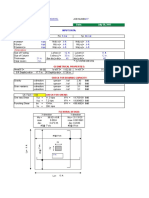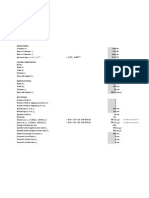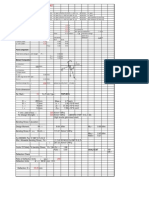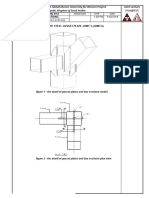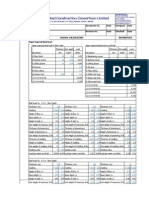Block Shear Example
Uploaded by
Dubu DubuBlock Shear Example
Uploaded by
Dubu DubuProblem:
The W150x24 tension member is connected as shown in the figure. All steel are A36 steel.
The bolts are A325, with threads excluded from shear planes. Compute the design and
allowable strength of the member based on block shear of the wide gusset plate.
d b := 16mm Bolt
diameter
d n := 18mm Nominal bolt
hole
tg := 12mm Gusset plate
thickness
Fy := 248MPa Yield
strength
Fu := 400MPa Ultimate
strength
Properties of W150x24:
2
Ag := 3060mm
d := 160mm
b f := 102mm
tf := 10.3mm
tw := 6.6mm
Bolt Spacings:
s1 := 40mm s2 := 80mm s3 := 30mm
Solution
:
d e := d n + 2mm = 20 mm Effective hole diameter
2
( )
Agv := s1 + 2 s2 tg 4 = 9600 mm Gross area subject to shear
2
( )
Anv := Agv - 2.5 d e tg 4 = 7200 mm Net area subject to shear
s4 := b f - 2 s3 = 42 mm
2
( )
Ant := s4 - d e tg 2 = 528 mm Net area sbuject to tension
Ubs := 1.0
R n1 := 0.6 Fu Anv + Ubs Fu Ant = 1939.2 kN Nominal strength for block shear
R n2 := 0.6 Fy Agv + Ubs Fu Ant = 1639.68 kN
LRFD :
ϕ := 0.75
(
R u_LRFD := ϕ min Rn1 , Rn2 = 1229.76 kN ) Design strength for block shear
ASD:
Ω := 2.00
(
min Rn1 , Rn2 ) Allowable strength for block shear
R u_ASD := = 819.84 kN
Ω
You might also like
- Design of Pedestal For Seismological Stations: Slenderness Ratio of The ColumnNo ratings yetDesign of Pedestal For Seismological Stations: Slenderness Ratio of The Column2 pages
- Larsen & Toubro Limited: ECC Division - EDRCNo ratings yetLarsen & Toubro Limited: ECC Division - EDRC21 pages
- T0516-Eco Sanctuary CPL 23-Feb-16 LYJ RC 250 850 2300: Design Calculation For Pilecap 3Rc250No ratings yetT0516-Eco Sanctuary CPL 23-Feb-16 LYJ RC 250 850 2300: Design Calculation For Pilecap 3Rc2503 pages
- Design of Long Wall: Tank Full and No Soil PressureNo ratings yetDesign of Long Wall: Tank Full and No Soil Pressure6 pages
- 05 - A Software Solution To Help Design Steel Beam To Column Connection PDF100% (1)05 - A Software Solution To Help Design Steel Beam To Column Connection PDF11 pages
- End Plates - Worked Examples With Partial Depth End Plate - Example 5No ratings yetEnd Plates - Worked Examples With Partial Depth End Plate - Example 51 page
- Unit-I Thin Plate Theory, Structural InstabilityNo ratings yetUnit-I Thin Plate Theory, Structural Instability78 pages
- DES_204_0551_14635_SGP INDUSTRIAL _BLDG A_REV00No ratings yetDES_204_0551_14635_SGP INDUSTRIAL _BLDG A_REV0011 pages
- MAX MAX: Shear Wall Design Based On ACI 318-02No ratings yetMAX MAX: Shear Wall Design Based On ACI 318-0216 pages
- Wcr= (h-x) 3 a ϵ 1+2 (a C) : Crack Width Calculation for ColumnNo ratings yetWcr= (h-x) 3 a ϵ 1+2 (a C) : Crack Width Calculation for Column3 pages
- Wind Loads Calculations by ASCE7 05 For Any BuildingNo ratings yetWind Loads Calculations by ASCE7 05 For Any Building12 pages
- Design of Column With Biaxial Moments: Loads DNo ratings yetDesign of Column With Biaxial Moments: Loads D4 pages
- Design of Restrained Slab (Bs 8110) : Mid-SpanNo ratings yetDesign of Restrained Slab (Bs 8110) : Mid-Span4 pages
- Project Job Ref. Section Sheet No./rev. Calc. by Date CHK'D by Date App'd by DateNo ratings yetProject Job Ref. Section Sheet No./rev. Calc. by Date CHK'D by Date App'd by Date3 pages
- SW Bracing - Eave Connection - Main bldg-R00No ratings yetSW Bracing - Eave Connection - Main bldg-R0014 pages
- Method of Superposition - Beam Deflection - Strength of Materials ReviewNo ratings yetMethod of Superposition - Beam Deflection - Strength of Materials Review7 pages
- B Effective Cover Type of Beam: Project TitleNo ratings yetB Effective Cover Type of Beam: Project Title2 pages
- Depth of Neutral Axis For Long Term Ec - (X) : Directly Under The Bar LocationNo ratings yetDepth of Neutral Axis For Long Term Ec - (X) : Directly Under The Bar Location2 pages
- Slab Design of Partially Fixed Circular SlabNo ratings yetSlab Design of Partially Fixed Circular Slab4 pages
- Princess Noura Bint Abdulrahman University For Women Project Joint Venture El Seif/CCCNo ratings yetPrincess Noura Bint Abdulrahman University For Women Project Joint Venture El Seif/CCC9 pages
- Design of Primary Beam: Concrete Grade M20 Steel Grade Fe 500No ratings yetDesign of Primary Beam: Concrete Grade M20 Steel Grade Fe 5006 pages
- Calculation of Hydrodynamic Pressures On Walls of Rectangular TankNo ratings yetCalculation of Hydrodynamic Pressures On Walls of Rectangular Tank7 pages
- MEMBER NAME: S1-One Way: MIDAS Information Technology Co., LTDNo ratings yetMEMBER NAME: S1-One Way: MIDAS Information Technology Co., LTD3 pages
- Lotsafee House: Bigbucks PLC Pilecap G14No ratings yetLotsafee House: Bigbucks PLC Pilecap G1453 pages
- Lecture 3 - Analysis and Design For Axial TensionNo ratings yetLecture 3 - Analysis and Design For Axial Tension10 pages
- Lecture 1 - Introduction Steel FamiliarizationNo ratings yetLecture 1 - Introduction Steel Familiarization15 pages




